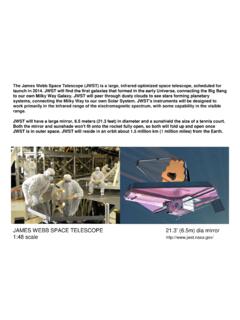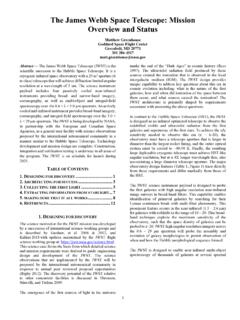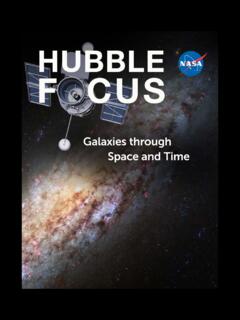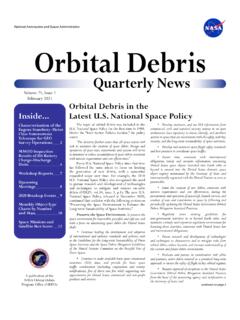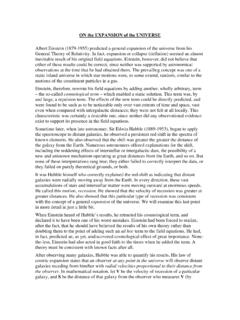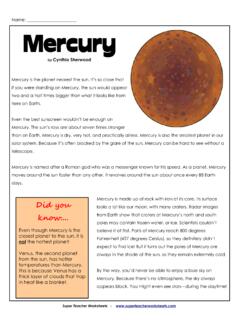Transcription of The James Webb Space Telescope: Why space telescopes are ...
1 The James Webb Space telescope : Why Space telescopes are important Credit: Illustration courtesy of NASA. Grade Level: 6 to 8. Lesson Duration: 2 x 50 minute periods Rationale: Later this decade, the James Webb Space telescope (Webb) will launch from Earth to unlock some of the most thought provoking questions of our time. Webb is the successor of the Hubble Space telescope (Hubble), stands 3 stories high and spans the size of a tennis court. This gargantuan telescope will reside 1-million miles from our planet; this is nearly 4 times the distance from the Earth to the Moon. Webb will study the formation of galaxies, planets outside of our Solar System, and newborn stars, by using the infrared part of the Electromagnetic Spectrum.
2 The meter segmented mirror of Webb has a light-gathering power of 7 times that of Hubble. To give students a perspective on the need for large Space -based telescopes , students will explore why these types of telescopes are necessary, and students will work together to construct scale models of the Hubble and Webb mirrors. This multi-disciplinary lesson will cover topics in art, science, and technology. Key Concepts: The importance of large Space telescopes and perspective Content Standards: National Science Education Standards (1996: Grades 5-8). A: Abilities of Technological Design o Implement a proposed design F: Science in Personal and Social Perspectives o Science and technology in society International Society for Technology in Education Standards (2007: Grades K-12).
3 1: Creativity and Innovation o B: Create original works as a means of personal or group expression o C: Use models and simulations to explore complex systems and issues National Standards for Visual Art (1994: Grades 5-8). 5: Reflecting upon and assessing the characteristics and merits of their work and the work of others o Students compare multiple purposes for creating works of art 6: Making connections between visual arts and other disciplines o Students describe ways in which the principles and subject matter of other disciplines taught in school are interrelated with the visual arts Learning Outcomes: Students will describe why Space -based telescopes are important. Students will, as a class, create scale models of the Webb and Hubble primary mirror and an artistic representation of a galaxy on the reverse side of each model.
4 Students will compare each mirror model and each galaxy representation. Students will additionally reflect on what differences exist between each model and how subjects like art and science can be interrelated. Instructional Procedure: 1. Begin the lesson by having students take out their science journals. Ask students Why are telescopes important? and Why do we need a Space telescope as opposed to a ground-based telescope ? Allow them time to write their responses in their journal. Have students pair up and ask them to share their responses with a classmate and then share with the class. 2. Have students gather around a window in the classroom or in the school. Spray the window with water by using a water mister. Guide students' understanding using an analogy that this window represents the Earth's atmosphere.
5 Have students focus their sight on a distant object on the other side of the glass. Ask them to describe the appearance of the object in as much detail as possible, and to discuss some of the challenges they face in viewing the object. Have them record these responses in their journal. 3. Repeat step 2, but this time have the students look at the same object through the window with a set of binoculars or a small telescope mounted on a tripod. Ask them to again describe the appearance of the object in as much detail as possible. Can they see more detail using the optical aid or less? Why? What is the problem of observing objects in Space from Earth? Have them record their responses in their journals. 4. Lift up the window and have the students look at that same object with only their eyes.
6 Ask them to describe the appearance of the object in as much detail as possible. How is this image different from the first time they viewed the object with the window closed? Have them record their responses in their journals. 5. Repeat step 4, but this time have the students look through the window with binoculars or a small telescope mounted on a tripod. Ask them to again describe the appearance of the object in as much detail as possible and again to record their answers in their journals. 6. Have students break into small groups and share their journal observations. Have each group share their answers with the class. Guide students' understanding that telescopes need to be in Space so that we do not see a blurry image.
7 Ask them Which view did they like the best? , and then How could you see more detail to view the image even better? . Student responses should discuss the need for a bigger pair of binoculars or telescope to see an object in more detail. 7. Relate the view seen with their eyes through the open window, to that of the Hubble Space telescope . Explain to students that we need larger telescopes in Space to see celestial objects in more detail. The view of the object through binoculars or a small telescope compared to the unaided view is the kind of difference that you would see with a larger telescope in Space compared to a smaller one in Space , such as the James Webb Space telescope compared to the Hubble Space telescope .
8 8. Break the class into two groups. One group will be the Hubble Space telescope Team (3. or more students) and the other the James Webb telescope Team (the rest of the class will need to be 18 students). Explain to the students that they will be making a scale model of the Hubble and the Webb mirrors. THE HUBBLE Space telescope TEAM. From the Resources Section at the end of this lesson, share Hubble facts with students. Students should have the understanding that they will be sharing what they believe is important from this information with the rest of the class. 9. Give the students an 8 x 8 sheet of cardstock and a similar size of tinfoil. Have the students Credit: Illustration courtesy of NASA. use a guide to trace and then cut out a circle with a diameter of of cardstock and tinfoil.
9 The students should then glue the tinfoil, shinny-side-up, to one of the sides of the cardstock circle. 10. Reference the illustration at the end of this lesson that depicts the primary mirror of Hubble. The illustration shows a galaxy. Assign the students to draw the galaxy on the non-tinfoil side of their model. Have students clean up their area when finished. James WEBB Space telescope TEAM. As the Hubble Team begins working on their telescope model have the Webb team work on theirs. From the Resources Section at the end of this lesson, share Webb facts with students. The students should have the understanding that they'll be sharing what they believe is important from this information with the rest of the class.
10 11. Explain to students that they are going to be making a scale model of Webb's primary mirror. Distribute one 5 x 5 sheet of cardstock and a similar size of tinfoil to the students. They will need 18 pieces to complete the mirror model. 12. Have each student use a guide to trace and then cut out a hexagon with a diameter of 4 . The students should have one hexagon made of cardstock and one of tinfoil. The student should then glue the tinfoil, shinny-side-up, to one of the sides of the cardstock hexagon. 13. Reference the illustration at the end of this lesson that depicts the 18 mirror segments of Webb. Each mirror segment shows a portion of a galaxy. Assign a mirror segment to the students so that they can draw the corresponding portion of that galaxy on the non-tinfoil side of their model.

